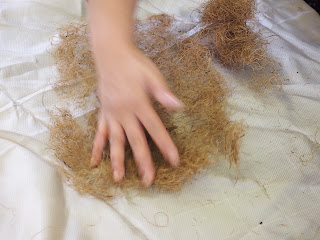An example of coconut fibre used in a dress by student from Ashland University, Oregan, USA.
experiment photoshop
experiment with leaves
making final adjustments in the studio
DiSCOVER
To being this project, I specifically used the technique of sewing as my main creative roll. I did same experiments using variety of unusual materials. Here are some ingredients into the pages of the book, movable experiments, tree leaves and to begin this project I actually used paper, plastic bags were among the first samples but I researched a lot of different variations fashion designer. When I saw this material, I wanted to do something different. I went to look at the material for the scrap shop and bought waste coconut fibre very cheaply.
Same techniques I used like cording, teasing, sewing, spraying and also ironing, originally were from processing more conventional materials.
The material which I used in my sketchbooks and for my experiments were sycamore tree leaves, coconut fibre, beech wood and some recycled book pages.
I estimate the cost of the dress to be £420 minimum including a label estimate of 60 hours on minimum rage but in a fashion context I could charge a lot more.
Same of material which I used for my experiment is tissue paper, book pages, coconut fibre, same button, money paper, beech wood, mash metal and leaves from sycamore trees.
The techniques for that garment I used were teasing out of fibre to make it looks like fabric cording the fibres to make it in to a sheet, ironing to flattening out the fibres and also sewing the fibre together into a useable and start to make a pattern to construct garment.
The last I used a model for my coconut fibre dress into an attractive styling garment by making alterations to the gown to make it fashionable and appealing.
On health and safety; I followed professional safety procedures at all times. There was nothing unhealthy about my materials.











































































No comments:
Post a Comment